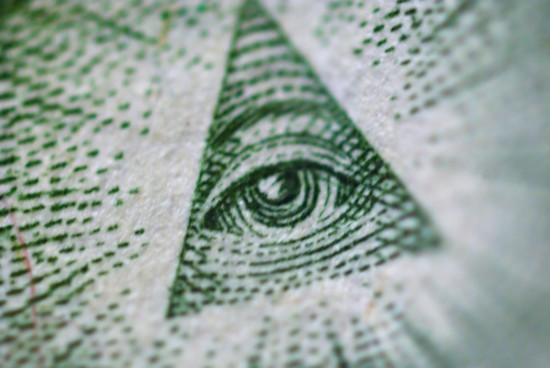Skip to main content
10 Symbols That Rule The World
1. The Egyptian Obelisk

The obelisk symbolizes the sun god Ra, the greatest of Egyptian gods.
When the cities legally independent of their host nations (Washington,
D.C., London City and Vatican City) decided to erect obelisks, their
triangular unity may have been a symbolic gesture of their superior
power.
2. Swastika

Before Hitler adopted the Swastika as a symbol of the National Socialist
Party, it had experienced a renaissance in Western Europe for several
decades as a symbol of luck and good fortune before Hitler borrowed
those sentiments to rally support behind the Nazi party.
In truth, the swastika has been found on objects from as early as
4,000-10,000 B.C. The Indus Valley Civilization religions of Hinduism,
Buddhism and Jainism still use the symbol to signify either divine
auspiciousness or the sun’s rays. In Buddhism, some believe a swastika
was stamped on Buddha’s chest when he was buried, known as the Heart’s
Seal.
3. Crosses

Before Christianity adopted the cross as its emblem, it was a pagan
symbol for the Sun-God and signified the perfect union of male and
female energy. (The original crosses had equal length axes). The Pope
still wears the original cross, which kind of makes sense when you
consider Christians hold Jesus as the Son of God.
The Roman Emperor, Constantine, was a practicing sun-worshipping pagan,
so perhaps the Roman Empire’s adoption of Christianity as its main
religion and consequently, the cross its main symbol, was of no
coincidence.
4. Star of David

While the hexagram is currently Israel’s primary symbol, representing
the Shield of David, its origins are far older than 1018 A.D., when the
first recorded Judaic use surfaced.
South Indian temples dating back thousands of years have hexagrams (some
with swastikas beside them) adorning their exteriors. The Hindus hold
the hexagram as a mandala and use it to represent the heart chakra. In
the ancient Tibetan Book of the Dead, there are images of a swastika
inside the hexagram representing the creative force in the universe.
If Hitler was trying to represent Jews as evil, he surely used the wrong
symbol. The hexagram is used in nearly a dozen religions around the
world, always signifying a positive or strong principle.
5. Muslim Crescent Moon

Although the use of “Holy Symbols” is against Muslim law, the crescent
moon adorns the flag of a few Muslim nations and has been adopted to
unofficially symbolize Islamic faith.
The crescent moon is one of humanity’s oldest symbols, representing the
feminine aspect of life, worshipped famously in the form of ancient
Greek goddess, Artemis, who always had a crescent moon circling her
head. In Roman times the symbol was adopted by Diana, a goddess of hunt
and moon, who was said to protect virgins.
6. The Eye of Providence

The famous symbol on the U.S. dollar bill is said to represent the eye
of god watching over the land. Masons use the symbol to remind them that
their actions and thoughts are always observed by the great architect
of the universe.
The Egyptians gave Horus a single eye surrounded by sun beams, while in
Buddhism the “Eye of God” means to open the top of the dome, the Sun
Gate, which is God consciousness.
7. The Jesus Fish

Used by Christians today to represent Jesus, the sign of the fish
(actually two intersecting arcs), the symbol was originally used by
Christians as a secret symbol of identification to avoid persecution.
The symbol dates back as far as ancient Egypt, Greece and Mesopotamia.
Fish are creatures of the water and thus were always associated with
cyclical birth and rebirth. The Mesopotamian god, Oannes, also known as
“the Reveler”, is said to be a precursor to Christ.
8. Arabic Hamsa

The hand-shaped amulet with an eye at the center of its palm is used
mostly in Arabic cultures as a protection against the evil eye. It’s
also known as the Hand of Fatima, for Mohammad’s daughter, and as the
Hand of Miriam in Judaism, for the sister of Moses.
The Open Hand had been used in ancient cultures: in Buddhism the open
hand signifies that all points of the teaching are visible, while in
Hinduism, the downward pointed open hand signifies “giving.”
9. The Serpent

In the Garden of Eden, Lucifer embodied the legendary form of a serpent,
slivering around the tree of knowledge, until the incorrigible Eve was
tempted into seeing her naked self, and thus banished from paradise
along with her mate and maker, Adam.
Before the Old Testament and Torah demonized the serpent forever, the
snake was a sacred symbol, meaning wisdom — specifically in Gnosticism,
Egypt’s competing religion. Gnostism borrowed the concept of Kundalini
energy from the Hindus, who believe the two nerves at the seat of the
spinal column can give rise to enlightened experience.
The most recent example of two serpents come in models of DNA, that show
the famous double helix, mirroring ancient Sumerian double-coiled
serpents.
10. The Pentagram

Although its modern association is devil worship, the pentagram is
everywhere in history and never associated to evil. In ancient Sumer,
the 5 points were tied to the five known planets, while the Greek
Pythagoreans thought the pentagram was mathematical perfection.
Symbolically, pentagrams have historically reflected the number 5, which
represents the conjunction of inequalities. According to the Dictionary
of Symbols, it was considered a key to higher knowledge.
A look from above at the nation capital’s urban planning reveals an
elaborate upside down pentagram within a hexagram. Most likely the
result of the freemasons who designed the city by appointment of George
Washington, a mason of the highest ranking.










Comments
Post a Comment